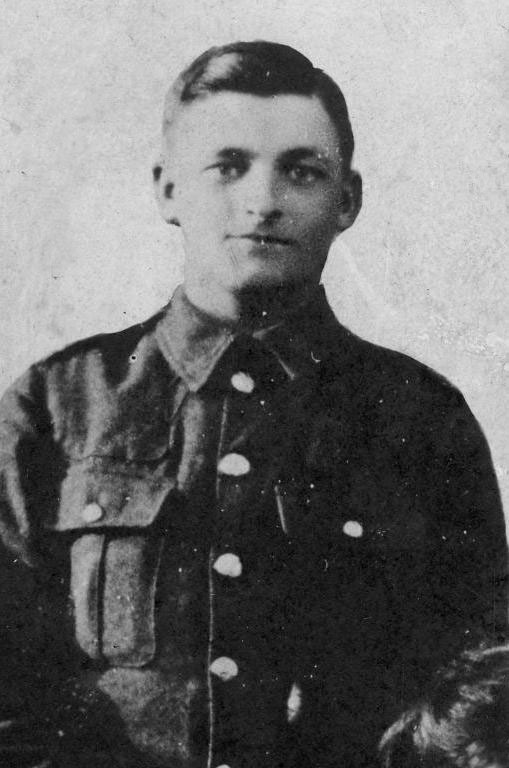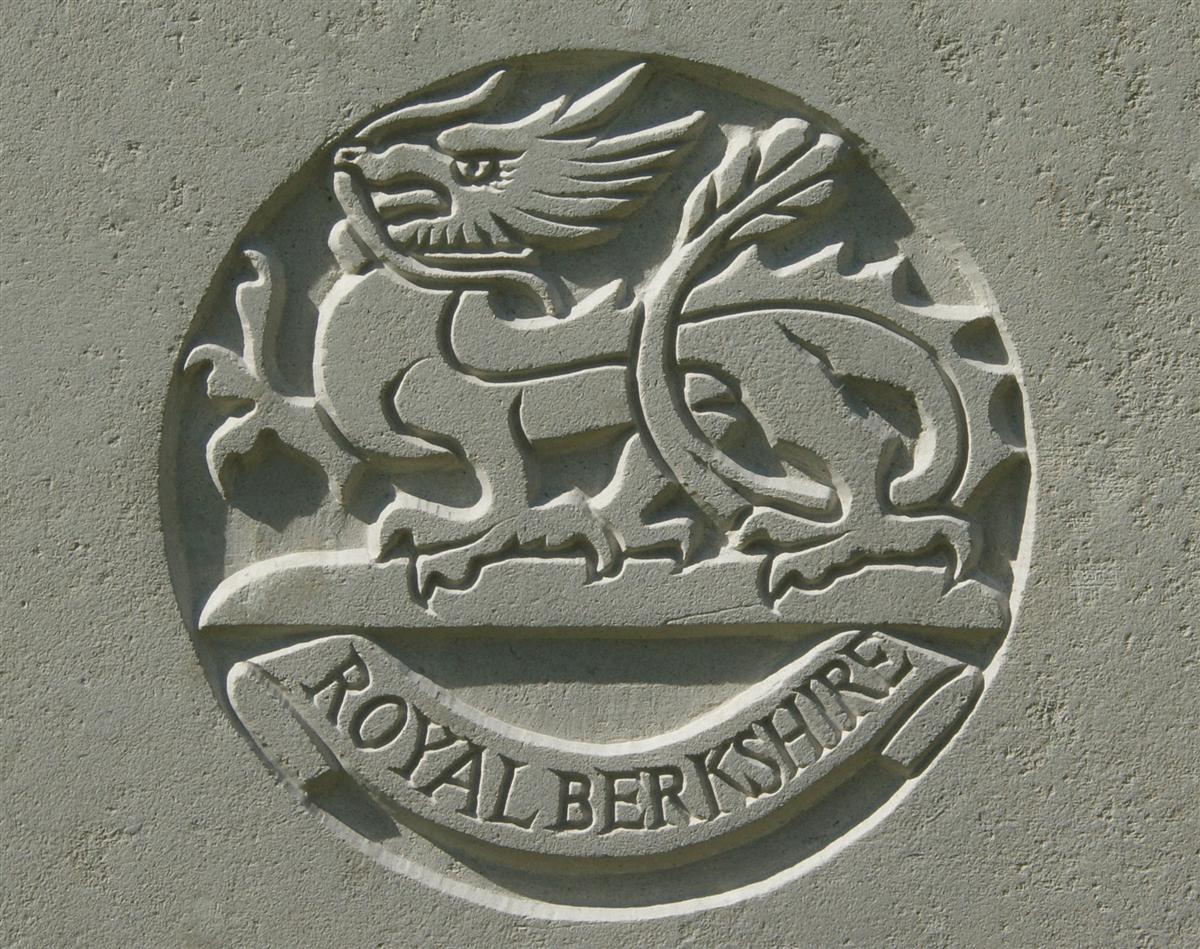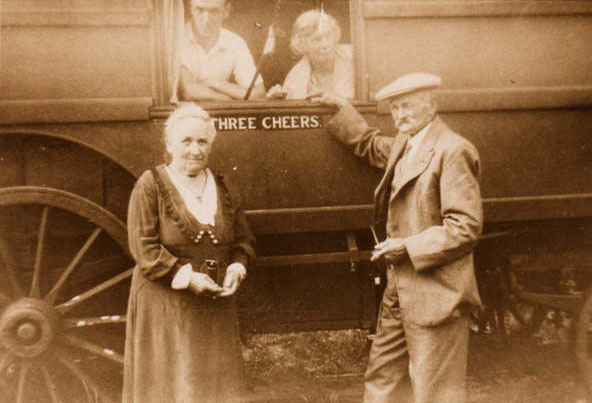Harry Albert Richard Fray
Private 9430 Harry Albert Richard Fray, 1st Battalion, Royal Berkshire Regiment

Harry Fray (Pat Burgess) |
Harry was born in Hampstead on 9 November 1891 the eldest of the eleven children of Harry Fray and his wife Rose née Cripps. Harry senior was an old soldier serving a full term with the King’s Royal Rifle Corps and afterwards in the Rifle Reserve Regiment. Outside of the army Harry senior earned a living as a groom and later as a coachman, bringing his family to Newbury ca1902 (Rose was from Bucklebury, perhaps her connections found Harry a job when he needed one after leaving the army). It seems that he was astute enough to foresee the impact of the motor car on his calling and found work with Martin & Chillingworth whose garage was on the corner of Oxford Street and The Broadway in Speenhamland.
When war came Harry senior once again donned the khaki uniform, re-enlisting in his old regiment, the King's Royal Rifle Corps (KRRC), on 4 March 1915, soon both father and son were appearing in the Active Service Rolls published in the local paper to honour the patriotic fervour of Newbury's regular soldiers and the volunteers who joined them in service before the introduction of conscription. He never served abroad; having been appointed to the 5th Battalion KRRC he was probably given a role in training or administration until, on 11 May 1918, he was discharged as 'no longer physically fit for war service'. He returned to Newbury and remained there for the rest of his long life; he died in 1950, aged 90.

Newspaper article listing Harry senior among the employees of Martin & Chillingworth who were serving their country (NWN 30 Mar 1916). |
Young Harry followed in his father’s footsteps and signed up for the regular army in 1910, well before the outbreak of war. He did not, however, choose his father’s old regiment, instead he signed on with the local infantry – the Royal Berkshire Regiment. On the outbreak of war he was with the 1st Battalion of the regiment in Aldershot and soon found himself on a boat to France, landing their on 13 August 1914, nine days after war was declared.
The battalion was part of the 6th Brigade, 2nd Division of the British Expeditionary Force (BEF) under Sir John French – the ‘Old Contemptibles’. Reading British histories it can seem that this valiant force was solely instrumental in halting the German advance into France and pushing them back into Belgium – and they certainly played a part, but they were only a very small part of the overall Allied Armies, massively out-numbered by the French.
The BEF first encountered the advancing Germans at Mons, and were then pushed back towards Paris until it seemed that the city would fall. However, a massive effort by the French, with the help of the BEF, halted the Germans at the River Marne and then, further south at the Aisne. Slowly the Germans were pushed back until neither side could make headway.
On 20 October the 1st Berks arrived in Ypres (Ieper) the beautiful old town that became all too familiar to the Tommies as ‘Wipers.’ When the battalion arrived the town was untouched by the war, soon it would be reduced to rubble. The war was in the phase known as the ‘Race to the Sea’ during which both sides attempted to outflank the other – which continued until their flanks were on the coast and the Swiss border.

The ruins of Ypres' mediaeval Cloth Hall. painted by Major James Kerr-Lawson |
On the 24th the brigade was at a point north of Frenzenburg when they were tasked to recapture positions along the Passchendaele—Becelaere road. The 1st Berks led the way capturing two German guns and taking 70 prisoners as they advanced 1,000 yards achieving all their objectives.
Berkshire Chronicle
October 24th will ever be a memorable one in the annals of the 1st Battalion of the Berkshire Regiment, for the enemy's trenches on the Passchendael - Becclaere road were captured with 70 prisoners; two of the Berkshire officers were awarded the DSO and two of the rank and file the DCM. It was accompanied also by heavy losses amongst the officers, but the Berkshires had the gratification of receiving very high commendation from the Major General commanding the 2nd Division.
For the following two days the battalion was under heavy bombardment but the Berkshires held out until relieved on the 27th. However, this was too late for Harry, he died in the bombardment of their positions on the 26th. He was 23.

The regimental badge of the Royal Berkshire Regiment, as used on CWGC headstones. |
1st Battalion, Royal Berkshire Regiment – War Diary, 26 October 1914
Trenches and reserve heavily shelled during the day. After dark the French took over the left half of B Coys trenches
When the news reached his parents in Newbury, they inserted a notice in the local paper:
Newbury Weekly News, 10 December1915 - Family Notices / Killed in Action
FRAY - Oct 26 Pte H. Fray, 1st Royal Berks, the beloved eldest son of Harry and Rose Fray, 20 Corporation Cottages, Newbury, killed in action at Zonnebeke, aged 23.
Gone a soldier, brother, friend
Sadly missed by one and all
One of the boys of the Royal Berks
Gone to answer the last roll call.
To mark the anniversary of his death another notice appeared:
Newbury Weekly News, 28 October 1915 - Family Notices / In Memoriam Harry's name on Newbury War Memorial (bottom right)
In ever loving memory of Pte. H. Fray, of Newbury, Royal Berkshire Regt. who fell at Zonnebeke, on October 26th, 1914.
One year has gone, still we miss him
Never can his memory fade
No friends near him to caress him,
Far away across the ocean
In a distant land he is laid
None to wipe away a tear
Called from earth to be with Jesus
One we loved so very dear
From Mother, Dad, Sisters and Brothers
Harry’s body was never identified so he has no known grave, instead he is commemorated on panel 45 of the Menin Gate memorial to the missing in Ieper. Locally he is remembered on tablet 5 of the Newbury Town War Memorial and the Speenhamland Shrine – Speenhamland’s war memorial which was originally sited in St Mary’s church in Speenhamland. When this church was demolished in the 1970s the Shrine was moved to St Nicolas’ church where it can be visited today.
Only one of Harry’s five younger brothers was old enough to take part in the fighting; Edgar William Fray (usually found as William Edgar - but known by all as 'Buller') was born on the 2nd March 1899 at Tisbury, Wiltshire. Buller was probably conscripted on his eighteenth birthday in 1917, first to the Royal Berkshire Regiment, probably for his basic training, before being posted to the 1st/4th Yorkshire Regiment.

Harry and Rose Fray in later life (Pat Burgess) |
Newbury Weekly News – Local War Notes, 18 July 1918
Mr and Mrs Fray, of 20, Corporation-cottages, Speenhamland, Newbury, would be thankful for any news of their son, Pte W E Fray, of the 4th Yorkshire Regt, of whom they have been officially informed he has been missing since May 27th, 1918.
A great many British troops were captured in the German Spring Offensive or Kaiserschlacht when a series of huge attacks pushed the British back as far as thirty miles in places. To hear that a loved one was missing left a hope that he was still alive somewhere, a hope that was all too often dashed when another communication arrived from the War Office informing the relatives that their son/husband/father had been ‘presumed dead’. In Buller’s case his parents and siblings were lucky, five months after he went missing they heard he was alive in a German prisoner of war camp.
Newbury Weekly News – Local War Notes, 7 November 1918
After five months of suspense Mr and Mrs Fray, of 20, Corporation Cottages, Newbury, have heard through the British Red Cross the welcome news that their son, Pte W E Fray, of the 1/4 Yorks, is a prisoner of war in Germany. A post card has also been received saying their son is well, but giving no address.
Buller returned to Newbury after the war and died there in 1968, aged 69.
After the war, in 1922, Harry and Buller's sister, Ada Alice Kate (Kit) married an ex-serviceman, Albert Admans MM, whose two brothers, Walter and Arthur died in the war and are remembered on the Shaw cum Donnington memorial.
Thanks to Karen Newbery for her help researching this soldier and to Harry's great-niece, Pat Burgess, for her input and the family photographs.

